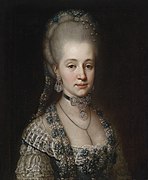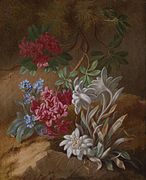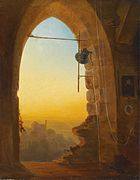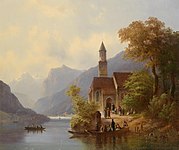Dorotheum
| Dorotheum GmbH & Co KG
|
|
|---|---|
| legal form | GmbH |
| founding | 1707 |
| Seat | Vienna |
| management | Martin Böhm, Lucas Tinzl |
| Number of employees | over 700 (including 200 abroad) |
| Website | http://www.dorotheum.com/ |
The Dorotheum is an auction house founded in 1707 with its headquarters at Dorotheergasse 17 in Vienna's 1st district, Innere Stadt . It is the largest auction house for art and applied arts in Central Europe and in German-speaking countries. In addition to the auctions, the trading area and the traditional pawn shop are also cornerstones of the Dorotheum.
Paintings, graphic works and sculptures as well as objects of applied art, in particular furniture, porcelain and jewelery from various centuries are auctioned at the Dorotheum. The objects are presented beforehand in exhibition rooms. Catalogs are available in printed and digital versions (Internet). There are also sales rooms.
In 1992 the Dorotheum received the state award and has been allowed to use the federal coat of arms in business transactions ever since .
Buildings and branches
The building is built in the neoclassical style. In 2001 the former state-owned company was sold to an Austrian consortium. The Dorotheum has expanded rapidly since then.
There are branches in 12 Viennese districts, in the Austrian federal states ( Dornbirn , Graz , Innsbruck , Klagenfurt , Linz , Pasching , Salzburg , Wiener Neustadt , St. Pölten ). There are also representative offices in Prague (since 1992), Brussels (since 1996), Düsseldorf and Munich (since 2003), Milan (since 2005) and Rome (since 2008), as well as contacts in Zagreb , Florence and a representative in Tokyo . It employs over 700 people worldwide, including 100 art experts. Every year around 600 auctions take place, which generate around 60 percent of total sales.
history
It was founded as the “Versatzamt zu Wien” in 1707 by Emperor Joseph I , at the same time as the Frag- und Kundschaftsamt . The first auction house was created. In addition to the pawn shop, foreclosure sales, which were carried out in a narrow circle to which the general public had little access, brought the most income. 80 years later, the move to the former Dorotheerkloster took place, the "Dorotheum" got its current name. At the end of the 19th century, primarily works of art, books, coins and stamps were auctioned. The new building of the Palais Dorotheum in Dorotheergasse on the site of the old monastery was completed in 1901.
Before the palace became the ancestral home of the internationally renowned Dorotheum, the original Versatz- und Fragamt from 1707 was already located in downtown Vienna. But it wasn't until the Dorotheum house, which was newly moved into in 1787, that it gave its identity and, above all, its name. The auction business experienced an upswing from the end of the 19th century. Auctions took place in 13 auction rooms.
Emperor Franz Joseph commissioned the new building of the palace on the same property as the former Dorotheerkloster, designed according to the plans of the famous Ringstrasse architect Emil von Förster, and in 1901 undertook the ceremonial opening. Förster should create something splendid without appearing wasteful. The official title “Dorotheum” for the house was introduced after the end of the monarchy in 1918. The “Kielmansegg Wall” in the current courtyard loading area of the Dorotheum is evidence of the historical building fabric. Here tombstones and reliefs were built into the wall named after the governor Count Kielmansegg , a structural renovator of the Dorotheum.
Kielmansegg laid the foundation for the modern auction house by also introducing the division into sections. While the auctions and your catalogs were previously a mixture of different art, antiques and collectibles, in 1900 a separate art department and the numismatics department were created.
The new spatial conditions of this inner-city palace, which was inaugurated in 1901, and increased demand allowed the auction system to flourish, and numerous special auctions were held. Particularly prominent collections were called up in the interwar period. The estate of the Austrian Nobel Peace Prize laureate Bertha von Suttner (1843–1914) changed hands, as did the entire furnishings of the Salzburg Palace in Kleßheim in 1921 , once owned by Archduke Ludwig Viktor. A large part of the collection of Albert Figdor , one of the largest private collectors in Europe, was also called up at Dorotheum. The auction rooms were grouped around the central main room, now called Kaiser Franz Joseph-Saal. The auction room, the “ Ludwigstorff Hall”, has over 170 seats and is derived from the name of this imperial advisor.
Role during the holocaust
The Dorotheum has been following the " connection accepted" Austria to the German Reich in March 1938th This also happened with other government agencies and auction houses. The old management was deposed by the Nazis and replaced by NSDAP party members Anton Jennewein and Franz Hofbauer . All Jewish employees were fired. Jennewein and Hofbauer endeavored to expand the auction business throughout the Reich with the protection of the Nazis. This was achieved at the beginning of the 1940s primarily through the auctioning of "Aryanized" movables and household effects. The " Aryanization " of numerous works of art via auctions in this state institution was formally legalized.
As a commission agent, the Dorotheum benefited from consignments from National Socialist agencies such as the Gestapo , the customs and financial authorities and the municipality of Vienna. The Dorotheum enjoyed almost a monopoly position in the Third Reich and was able to increase its profit enormously by selling the confiscated goods from former Jewish and other owners. The valuables were usually valued well below their real value in order to pay the owners as little as possible. When auctioned, the objects and chattels were of course sold at or just under their real value, which resulted in considerable profits.
After 1945 the Dorotheum adhered to the legal requirements, especially under the 3rd Restitution Act . These laws were so restrictive that it was almost impossible for the previous owners to regain their property. Not only did they have to prove for themselves what the former property was, but also buy back their former property, which was almost impossible as the Nazis took everything away from them. The Dorotheum refused to provide any further support or help for those who were looking for their “Aryanized” belongings. Lists of the stolen property were later destroyed, which made restitution even more difficult. To this day it is no longer possible to determine whether the owners were Jewish or who the legal heirs of many objects are.
Working through history
The privatization of the company started in 2001. After decades of social democratic chancellor with little activity, strong international pressure has set in since the FPÖ's participation in the new government in 2000 , including from Austria's Jewish religious communities, and the Dorotheum has been exposed to increasing criticism. A first important step and a symbolic act towards the victims and descendants was the payment of 32 million US dollars from the proceeds of the Dorotheum sales into the “ General Settlement Fund for Victims of National Socialism ”.
Another expression of the assumption of responsibility by the new management was the establishment of a separate department for provenance research . This makes the company the first and only auction house in German-speaking countries to have set up such an agency. The cooperation with victims' associations and in particular the Israelitische Kultusgemeinde Wien was intensified.
A fundamental activity of the historians was to sift through, process and organize the files (1933–1967) in the Dorotheum. These sources were handed over to the Austrian State Archives and made available to the public. The historians Sonja Niederacher , Alexander Schröck and Stefan August Lütgenau presented the company's history and analysis of the company after several years of research, taking into account domestic and foreign archives.
In the spring of 2006, the Dorotheum presented the study Between State and Economy. The Dorotheum in National Socialism to the public. At the same time, the historical files from the Dorotheum were made accessible to the public by being handed over to the Austrian State Archives . The historian Sonja Niederacher wrote in the daily newspaper Der Standard : “On an economic level, the Dorotheum benefited from the Nazi regime”. Dorotheum managing director Martin Böhm spoke of a “symbolic act”, an “act of responsibility towards history.” At the same time, he publicly asked “all those affected who have suffered suffering on the part of our company for an apology”.
privatization
The Dorotheum, which until then had been a sui generis legal entity , was converted into a limited liability company with effect from January 1, 1979 . The company was owned by the federal government and was handed over to ÖIAG in 1998 for the purpose of privatization. The 100% privatization itself then took place in September 2001 under the direction of Finance Minister Karl-Heinz Grasser . The buyers were the Carinthian entrepreneur brothers Erwin and Hanno Soravia ( Soravia Group ) and the media entrepreneur Christoph Dichand , who at that time already ran the Internet auction house OneTwoSold (1999–2008) together. The privatization was heavily criticized by the audit office because of low revenues and high costs for the investment bank involved. However, subsequent criminal investigations against Grasser were discontinued
Renoir theft
On November 26, 2018, an oil painting by Pierre Auguste Renoir "Limoges 1841-1919 Cagnes / Nice, Golfe, mer, falaises mertes", from 1895, 27 × 40 cm, framed, was stolen. Suspects were identified on images from surveillance cameras. Approximately in the period 8-10. December a suspect was caught in Amsterdam.
Antiques and jewelry trade
Since 1978, the trading area has been a further division of the Dorotheum. In sales galleries, now called Dorotheum Galerie, anyone can purchase art, decorative items and antiques immediately, regardless of auctions . Together with Dorotheum Juwelier, this branch is one of the three mainstays of Dorotheum in the anniversary year 2007. Traditional silver and gold jewelry, wristwatches and a fashionable trend line are offered in 29 locations in Austria, making Dorotheum the largest jewelry supplier in the country. The expansion into the international jewelery business was prepared by the purchase of the largest Hungarian jewelery retail chain OREX - a traditional company that still keeps its name - in 2004. The jewelery laboratory not only tests jewels for auctions, but also issues reports and certificates on the authenticity and quality of stones and makes estimates.
Dorotheum as a patron of the arts
As a sponsor of the MUMOK (Museum of Modern Art Foundation Ludwig Vienna), the Dorotheum organizes the “Museum Days”, to which the public has free entry. It also financed the permanently installed “White Cube” by the renowned artist Heimo Zobernig , a connecting bridge in the museum. Dorotheum initiated the establishment of the “Art Cluster Vienna”, an association of all of the major Viennese art houses, museums and art colleges that want to promote Vienna as a location more internationally in connection with art and business. The Art Cluster has been setting a big example since 2004 with the “Vienna Art Week”, a week of art with special events such as special tours, art dinners, panel discussions and much more, which takes place at the same time as the Viennafair contemporary art fair in April Sanct Lucas, the Liechtenstein Museum and LGT organized the “viennaartbookaward” endowed with 25,000 euros.
Auctions

The main attraction of the Dorotheum, which was included in the founding patent from 1707, is the daily auctions. The team handles around 600 annually in the Austrian federal states, in Prague and above all in Vienna. In the four annual "auction weeks" the focus is on modern and contemporary art, 19th century art, silver, glass and porcelain, jewelery , clocks, Art Nouveau, furniture, sculptures, master drawings and the old masters . The expert Peter Wolf discovered a painting as being by Hans von Aachen , the trace of which had been lost over the centuries. It was sold to the Kunsthistorisches Museum in Vienna for 472,000 euros.
Other names
The Viennese also refer to it as “das Pfandl” (pawn shop) or “Aunt Dorothee”, whom one likes to “borrow” something. Under this title Ludwig Hirsch sang about an auction with macabre Viennese humor on his gruesome album Komm big black bird , published in 1979 .
Supervisory board
The members of the supervisory board are Erwin Soravia, Alfred Karny, Michael Tojner and Johanna Dichand.
art
Georg Flegel : Still Life
Adele Schuster : Alpine flowers
Josef Neugebauer : Still life with a clock
Angiolo Romagnoli : The Little Darling 1873
Bernhard Stange : The evening bell
Albert Joseph Franke : At the antique dealer
Anton Hansch : View from Lake Gosau to the Dachstein
Adolf Eberle : Musical entertainment on the Alm
Anton Doll : On the way home from Sunday mass
August Borckmann : Tea time on the veranda 1889
literature
- Stefan August Lütgenau, Alexander Schröck, Sonja Niederacher: Between the state and the economy. The Dorotheum under National Socialism . Oldenbourg Verlag, Vienna 2006. ISBN 3-7029-0542-1 .
- PARNASS art magazine. Art restitution . Edition 4/2006. Vienna.
- Andreas Kloner: Aunt Dorothee. For the 300th birthday of a Viennese institution . ORF radio feature 2007, 54 min.
- Felix Czeike : The Dorotheum: from the relocation and fragment office to the modern auction house . Vienna [u. a.]: Youth and People 1982.
- Direction of the kk Versatzamtes (ed.): K. k. Displacement office in Vienna from 1707 to 1900 . Self-published by the kk Versatzamt, Vienna 1901 ( archive.org - copy of Google book).
Web links
- Dorotheum website
- Early documents and newspaper articles on Dorotheum in the 20th century press kit of the ZBW - Leibniz Information Center for Economics .
Individual evidence
- ↑ Address offices - a project outline . In: tantner.net .
- ↑ Robbed neighborhood ( Memento of the original from August 9, 2009 in the Internet Archive ) Info: The archive link was inserted automatically and has not yet been checked. Please check the original and archive link according to the instructions and then remove this notice. Auction list of the Dorotheum of the house contents of Bernhard and Nelly Altmann. A project of the VHS Hietzing , 2008.
- ↑ Der Standard, March 17, 2006
- ↑ cf. the Dorotheum Act, Federal Law Gazette No. 66/1979 and the government bill for it
- ↑ cf. the federal law on the transfer of the Dorotheum into the ownership of ÖIAG, Federal Law Gazette I No. 65/1998
- ↑ ricardo.at starts in Austria APA, ots.at, August 14, 2008, accessed December 13, 2018.
- ^ Dorotheum privatization: Trial for false testimony against ex-Soravia manager , profile from March 26, 2011, accessed on August 27, 2016
- ↑ Report of the Federal Audit Office 2012/8 , accessed on August 27, 2016
- ↑ Dorotheum: Investigations against Karl-Heinz Grasser discontinued , derstandard.at of August 24, 2016, accessed on August 27, 2016
- ^ Dorotheum - Imprint . In: dorotheum.com .
Coordinates: 48 ° 12 ′ 22 ″ N , 16 ° 22 ′ 6 ″ E














